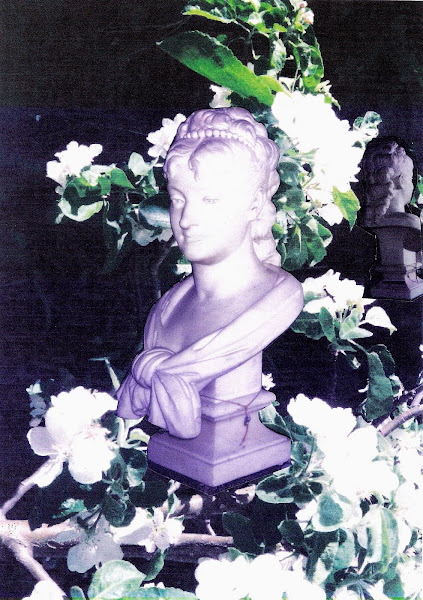This is an introduction to my novel GEORGE Napoléons tragédienne
My book is my tribute to the great French actress, Marguerite Joséphine Weimer, Mlle George. She was born in Bayeux, in 1787. She grew up in the shadow of the great revolution and started her remarkable career during the rule of Napoléon I. She continued to be one of the greatest tragedy actresses in Europe until she died in 1867. She has still the power of attraction.
As a resercher, living in Paris for a time, some years ago, I decided to visit Mlle George's tomb in Père Lachaise. This cemetery is like an old town with avenues, squares, gardens and parks. Instead of houses there are tombs, equivalent to the importance of the persons resting there. I met young people asking for Jim Morrison's tomb. In order to find the tomb belonging to Mlle George (and the tomb belonging to Jim Morrison), I had to buy the handy book Une heure au Père Lachaise, written and sold by Vincent de Langlade. He was just about to guide people through the famous cemetery. This lad was not sentimental about this holy place. But his book was helpful. The classification of 2500 names is made by "Division" from the 1st to the 97th. I found Mlle George at number 9, under a huge chestnut. Her tombstone with the name "GEORGE" only, was marked by age. But the tomb had signs of honour. There was proof of love and admiration. The tomb was decorated with lovely gifts and souvenirs. It was hard to find a spot where I could place my beautiful red rose.
Mlle George made her debut on the French stage, when she was very young. She was fifteen years old when she appeared on The Comédie Française in the main role of Queen Clytemnestre in Racine´s Iphigénie. Napoléon was enchanted. She became his favorite on the stage and in his private life. She was – for a time – his mistress. But – in my novel I do not reduce her to be a toy for "mad men". My intension is to point out her skill as an actress, her social and cultural competence and her ability to persist in pointing out women's rights. At least for her own course.
C. Conrad Cady who has created a wonderful Web Site
| Le site web Alexandre Dumas père | The Alexandre Dumas père Web Site | |||
 | ||||
| Dumas|Oeuvres|Gens|Galerie|Liens | Dumas|Works|People|Gallery|Links | |||
It is the portrait of the young Marguerite Jopséphine Weimer. She is a beautiful woman. She comes from an educated middle class family. Her father is the director of the theatre in Bayeux and later on of the important theatre-house in Amiens. Her mother is a wonderful and beloved actress. Her parents have high ambitions. She gets, in spite of being a girl and in spite of sometimes bad domestic economy, an excellent education.
As you can see on the painting, she is surrounded by books. It seems as if a visitor just enters her room and interrupts her in her studying. You get the impression of a young person who has decided herself to be an independent woman. But in a way she seems fragile.
My novel about Mlle George, begins in Russia, in Saint Petersburg.
When you, dear reader, first meet Mlle George she is forced to leave Russia because of her former lover, Napoléon. It is cold, it is January, in 1813. Mlle George is preparing to flee Russia, where she, since June 1808, has performed tragedies and comedies on the Imperial theatre in Saint-Petersburg and in Moscow. The Russian aristocracy and the Russian people admire her. Mlle George has been kindly received by the tsar Alexander. In fact, Alexander and Mlle George have fallen in love with each other. A Liaison impossible.
Mlle George must, this very day in January in 1813, forever close her door to her home in Saint Petersburg. She must flee. Napoléon and his immense army has invaded Russia and reached Moscow. But he has been defeated by the Russian army and the Russian winter. Mlle George has to escape! She has an invitation to Sweden, where Charles Jean Bernadotte recently had become Prince Charles Jean (Kronprins Karl Johan) and the real leader of Sweden. Lucky for her! She can take refuge in Sweden. But the journey will be risky...
©Lillemor Brink
As you can see on the painting, she is surrounded by books. It seems as if a visitor just enters her room and interrupts her in her studying. You get the impression of a young person who has decided herself to be an independent woman. But in a way she seems fragile.
My novel about Mlle George, begins in Russia, in Saint Petersburg.
When you, dear reader, first meet Mlle George she is forced to leave Russia because of her former lover, Napoléon. It is cold, it is January, in 1813. Mlle George is preparing to flee Russia, where she, since June 1808, has performed tragedies and comedies on the Imperial theatre in Saint-Petersburg and in Moscow. The Russian aristocracy and the Russian people admire her. Mlle George has been kindly received by the tsar Alexander. In fact, Alexander and Mlle George have fallen in love with each other. A Liaison impossible.
Mlle George must, this very day in January in 1813, forever close her door to her home in Saint Petersburg. She must flee. Napoléon and his immense army has invaded Russia and reached Moscow. But he has been defeated by the Russian army and the Russian winter. Mlle George has to escape! She has an invitation to Sweden, where Charles Jean Bernadotte recently had become Prince Charles Jean (Kronprins Karl Johan) and the real leader of Sweden. Lucky for her! She can take refuge in Sweden. But the journey will be risky...
©Lillemor Brink



Inga kommentarer:
Skicka en kommentar